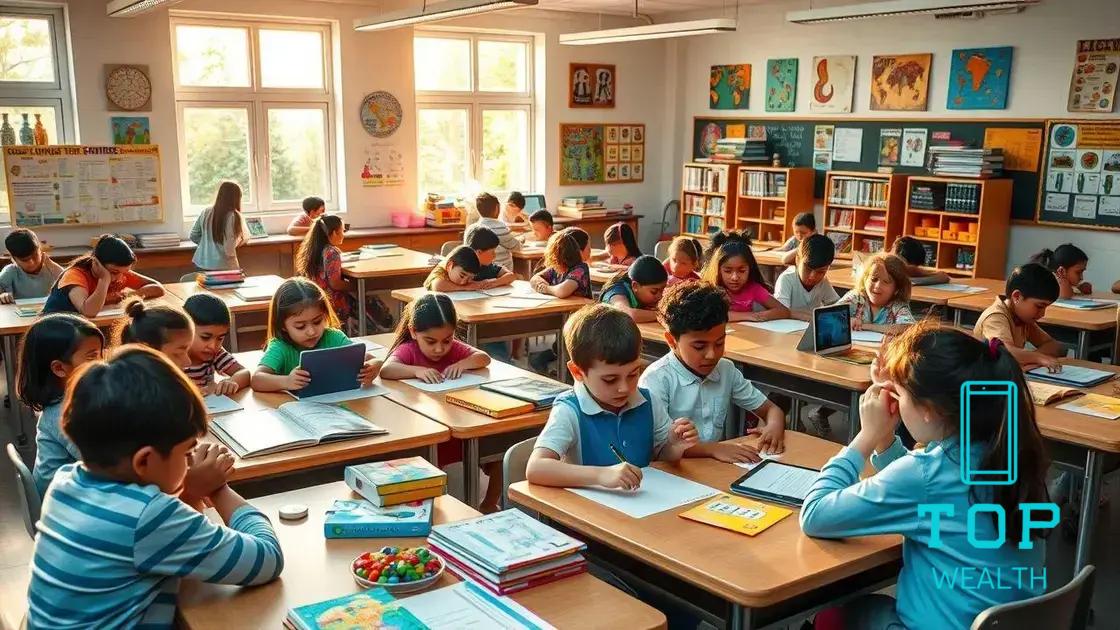Budget shifts redirect education investment nationwide

Budget shifts redirect education investment nationwide influence how schools allocate resources, affecting staffing, classroom materials, technology access, and overall educational quality, necessitating community engagement and advocacy for equitable funding.
Budget shifts redirect education investment nationwide are causing waves across various school districts. Have you noticed how these changes can affect local education? Let’s dive into the details.
Understanding the current budget shifts
Understanding the current budget shifts has become essential for anyone interested in education today. These changes in funding reflect broader economic patterns that influence how schools allocate resources.
One of the main factors driving these shifts is policy changes at both state and federal levels. Policymakers are often reevaluating where funds should be directed to maximize student outcomes. Recognizing how these policies impact individual schools can help communities understand the reasons behind budget decisions.
Key Factors Influencing Budget Shifts
Several elements contribute to the current trends in education funding:
- Population Changes: As regions grow or shrink, the demand for educational resources fluctuates.
- Economic Conditions: Economic downturns often lead to budget cuts, while recovery can increase funding.
- Federal Initiatives: New programs and initiatives from the federal government can redirect funds to specific needs.
- Community Involvement: Local advocacy groups can push for changes in funding allocation based on community priorities.
Moreover, understanding the intricacies of how budget shifts occur can help stakeholders, such as teachers and parents, engage with the process. It’s not merely about numbers; these shifts impact classroom resources, staff hiring, and even extracurricular activities. When one school receives extra funding, it often comes from a pool that might limit another school’s budget.
Awareness of these dynamics fosters a better dialogue between communities and schools. As the landscape of education funding continues to evolve, being informed about current budget shifts will empower users to contribute to discussions about how best to support local education systems.
Key impacts on education funding
Key impacts on education funding can shape the future of schools and students alike. Understanding these impacts helps communities advocate for better resource allocation.
When budget shifts occur, one of the most noticeable effects is on staffing levels. Schools may have to make tough decisions about hiring teachers or support staff. This can lead to larger class sizes and fewer resources for individual student needs.
Effects on Classroom Resources
As funding fluctuates, classroom resources are often impacted directly. This can include:
- Textbooks and Materials: Schools may struggle to provide updated materials if budgets are tight.
- Technology Access: Funding cuts can limit access to computers and other tech tools, putting students at a disadvantage.
- Extracurricular Activities: After-school programs may face reductions or even elimination, affecting student engagement.
In addition, changes in funding can influence the quality of education offered. Schools that receive less funding may have a harder time attracting and retaining skilled teachers. This can negatively affect student learning outcomes and overall school performance.
Community responses play a vital role as well. Parents and local organizations often mobilize to address funding gaps. They might organize campaigns to raise awareness, pushing for more equitable distribution of resources.
Moreover, understanding these impacts encourages conversations about how best to support educational systems. Schools, communities, and policymakers must work together to create solutions that provide all students with the opportunity to succeed. Fostering dialogue around education funding helps build a stronger foundation for future generations.
How schools are adapting to changes
How schools are adapting to changes in education funding is a crucial topic for students and educators. As budgets shift, schools are finding innovative ways to maintain quality education.
One major strategy involves collaborative partnerships. Schools are teaming up with local businesses and organizations to gain additional resources. These partnerships can provide everything from financial support to internship opportunities for students. By connecting with the community, schools can enhance educational programs without solely relying on government funding.
Utilizing Technology
Another effective adaptation is the increased use of technology in classrooms. Many schools are investing in digital tools and online resources to supplement traditional teaching methods. This allows students to access a wealth of information and learning materials beyond what is available in textbooks. Technology can also support personalized learning, ensuring that students receive instruction tailored to their needs.
- Online Learning Platforms: These platforms give students and teachers access to courses and resources from anywhere.
- Interactive Tools: Apps and software can make learning more engaging and help with difficult subjects.
- Virtual Field Trips: Technology enables classrooms to explore places and experiences they may not be able to visit physically.
Moreover, schools are focusing on teacher training to better equip educators to handle changes in funding. Professional development programs are being revised to ensure teachers are prepared for new challenges. For example, they may learn how to integrate technology effectively or manage larger classrooms.
School districts are also advocating for better policies. They work with local governments to secure more stable funding sources. This proactive approach helps build stronger educational environments for students, regardless of budget constraints. Schools that take an active role in advocating for their needs are often better positioned to thrive despite financial challenges.
As schools continue to adapt to these changes, they remain committed to providing quality education. Understanding these adjustments is vital for parents and the community, as it affects not only the school environment but also student success.
Community responses to education investment shifts

Community responses to education investment shifts are vital in shaping the future of local schools. When budget changes occur, communities often come together to voice their concerns and advocate for their children’s education.
One common response is the formation of parent-teacher associations (PTAs). These groups play a crucial role in organizing efforts to support schools financially. They host events to raise funds and provide resources that schools may lack due to budget cuts. By working collaboratively, parents and teachers can ensure a stronger educational environment for students.
Advocacy Groups
In addition to PTAs, many communities establish advocacy groups focused on education issues. These organizations aim to inform the public and policymakers about the impacts of funding changes. They often organize campaigns to push for more equitable funding and better educational resources. Their voices can amplify the needs of schools and help drive legislative changes.
- Awareness Campaigns: These often use social media and community meetings to spread the word about education funding issues.
- Petitions: Community members may gather signatures to support initiatives for increased funding.
- Public Forums: Hosting discussions allows community members to share concerns and ideas.
Furthermore, community responses can also include local business support. Many businesses recognize the importance of education for the community’s future. They may provide sponsorships or donations to schools, helping to fill in funding gaps. This relationship between businesses and schools fosters a sense of shared responsibility for educating the next generation.
As communities adjust to shifts in education investment, they highlight the importance of staying informed and engaged. Parents and residents who participate in school board meetings can help shape policies and decisions related to funding. This engagement is crucial for advocating effectively for their children’s educational needs.
Working together, communities can overcome challenges posed by budget changes and support schools. When everyone contributes, it leads to a more robust educational system that benefits all students.
Future trends in education funding
Future trends in education funding are crucial to understanding how schools will operate in the coming years. As funding sources evolve, they will impact classroom experiences and the quality of education.
One trend to watch is the increasing reliance on technology integration. Schools are looking for new ways to incorporate technology into the learning process. This can lead to more online resources, which can reduce costs for outdated materials. With better technological tools, teachers can provide more engaging and personalized education.
Alternative Funding Sources
Moreover, schools are exploring alternative funding sources to support their needs. For example, crowdfunding has become a popular method for educators to raise money for specific projects. Parents and community members can contribute directly to initiatives they believe in. This not only helps raise funds but also builds community involvement in education.
- Grants and Sponsorships: Many schools seek grants from organizations focused on education. These can provide much-needed financial support.
- Partnerships with Local Businesses: Collaborating with local companies can lead to financial contributions or supplies and resources.
- Alumni Contributions: Engaging alumni to give back to their schools can help build funds for current students.
Another emerging trend is the push for equity in funding. Many advocates emphasize the importance of equitable distribution of resources across schools. This movement seeks to address disparities between wealthier and underfunded districts, ensuring that all students have access to quality education.
As schools adjust to these trends, they will continue to innovate and find ways to meet the needs of their students. Understanding these future trends in funding helps parents, educators, and communities prepare for the changes ahead. By staying informed, everyone can participate in important discussions about the direction of education.
In conclusion, understanding the shifts in education funding and how communities respond is essential for building a better future for our schools. By focusing on partnerships, technology, and advocacy, we can positively impact our students’ education. Embracing these changes will help ensure that all students have access to the resources they need to succeed.
FAQ – Frequently Asked Questions about Education Funding Shifts
What are the main causes of shifts in education funding?
Shifts in education funding can be caused by changes in government policy, economic conditions, and demographic shifts in student populations.
How can communities respond to funding cuts in education?
Communities can respond by forming advocacy groups, hosting fundraising events, and partnering with local businesses to support schools.
What role does technology play in education funding changes?
Technology is increasingly used to enhance learning experiences and can provide cost-effective solutions for schools, especially during budget constraints.
Why is equitable funding important for schools?
Equitable funding ensures that all students, regardless of their background or the wealth of their district, have access to quality education and resources.





